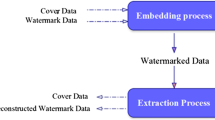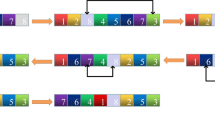Abstract
In this paper, the truth that the current reversible data hiding algorithms are detectable is confirmed by experimental analysis method. By analyzing the distributions of horizontal pixel difference of natural images and watermarked images using several models, we find that the horizontal difference histogram of natural image is significantly altered after being embedded secret message. Furthermore, the difference between the horizontal and the vertical difference histogram of natural image is much less than that of the watermarked image. Then the presence of hiding message can be detected according to the distance between the horizontal and the vertical difference histogram. Experimental results demonstrate that our approach is effective and efficient than the already published schemes.





Similar content being viewed by others
References
Alattar AM (2004) Reversible watermark using the difference expansion of a generalized integer transform. IEEE Trans Image Process 13(8):1147–1156
Celik MU, Sharma G, Tekalp AM (2005) Saber, E.: Lossless generalized-LSB data embedding. IEEE Trans Image Process 12(2):157–160
Coltuc D, Chassery JM (2007) Very fast watermarking by reversible contrast mapping. IEEE Signal Process Lett 14(4):255–258
Fridrich J, Goljan M, Di R (2002) Lossless data embedding—new paradigm in digital watermarking. EURASIP J.Appl, Signal Process., Special Issue on Emerging Application of Multimedia Data Hiding 2002: 185–196
Goljan M, Fridrich J, Holotyak T (2006) New blind steganalysis and its implications. In Security, Steganography, and Watermarking of Multimedia Contents VIII 6072:607201–1
Grenander U, Srivastava A (2001) Probability models for clutter in natural images. IEEE Trans Pattern Anal Mach Intell 23(4):424–429
He JH, Huang JW (2006) Steganalysis of stochastic modulation steganography. Science in China: Series F Inform Science 49(3):273–285
Honsinger C W, Jones P, Rabbani M, Stoffel J C (2001) Lossless recovery of an original image containing embedded data. U.S. Patent 6278791
Hu YJ, Lee HK, Chen K, Li JW (2008) Difference expansion based reversible data hiding using two embedding directions. IEEE Trans Multimedia 10(8):1500–1512
Hu YJ, Lee HK, Li JW (2009) DE-based reversible data hiding with improved overflow location map. IEEE Trans Circuits Syst Video Technol 19(2):250–260
Kamstra L, Heijmans HJAM (2005) Reversible data embedding into images using wavelet techniques and sorting. IEEE Trans Image Process 14(12):2082–2090
Kim HJ, Sachnev V, Shi YQ, Nam J, Choo HG (2008) A novel difference expansion transform for reversible data embedding. IEEE Trans Inform Forensics Security 3(3):456–465
Ni Z, Shi YQ, Ansari N, Su W (2006) Reversible data hiding. IEEE Trans Circuits Syst Video Technol 16:354–362
Thodi DM, Rodriguez JJ (2004) Prediction-error based reversible watermarking. IEEE Int Conf Image Proc 3:1549–1552
Tian J (2003) Reversible data embedding using a difference expansion. IEEE Trans Circuits Syst Video Techn 13:890–896
Weng SW, Zhao Y, Pan JS, Ni R (2008) Reversible watermarking based on invariability and adjustment on pixel pairs. IEEE Signal Process Lett 15:721–724
Xuan G, Yao Q, Yang C, Gao J, Chai P, Shi YQ, Ni Z (2006) Lossless data hiding using histogram shifting method based on integer wavelets. In Int. Workshop Digital Watermarking (IWDW) 4283:323–332
Acknowledgement
This work was supported by National Natural Science Foundation of China (NSFC) under grant No.60702025, the Research Foundation for Doctoral Program of Higher Education (RFDP) under grant No. 20070613024, Sichuan Youth Science & Technology Foundation of China under grant No. 07ZQ026-004.
Author information
Authors and Affiliations
Corresponding author
Rights and permissions
About this article
Cite this article
Zhao, H., Wang, H. & Khurram Khan, M. Statistical analysis of several reversible data hiding algorithms. Multimed Tools Appl 52, 277–290 (2011). https://doi.org/10.1007/s11042-009-0380-y
Published:
Issue Date:
DOI: https://doi.org/10.1007/s11042-009-0380-y




